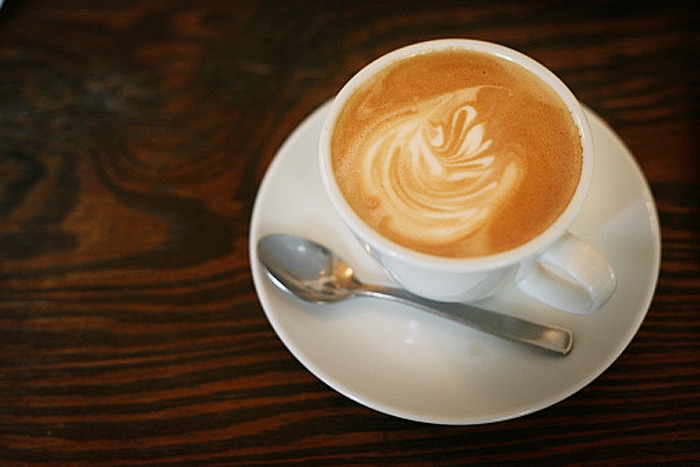
Written By: Owennie Lee, RD
Title: Registered Dietitian
Alumni: University of British Columbia
Last Updated on:

Whether you are a coffee drinker or not, it is difficult to ignore the omnipresence of this dark-colored aromatic drink. From the convenience of instant coffee to the sophistication of a hand-crafted espresso drink finished with spectacular latte art, there is a cup of java for every coffee drinker. So what are the nutritional differences between the numerous varieties of coffee beverages?

| Type of Coffee | Typical Serving Size | Caffeine Content (mg) |
|---|---|---|
| Brewed Coffee (generic) | 8 oz. | 133 |
| Brewed Coffee (Starbucks) | 12 oz. ("Tall") | 240 |
| Instant Coffee | 8 oz. | 93 |
| Espresso (generic) | 1 oz. | 40 |
| Espresso (Starbucks) | 1 oz. ("Solo") | 75 |
| Decaf Coffee or Espresso | any size | ~ 4-5 |
The caffeine content of your coffee beverage depends on a number of factors, such as the variety of the coffee bean and the brewing method. Usually, the longer the grounds are in contact with water and the finer the grind, the more caffeine is extracted. In general, espresso contains more caffeine than drip coffee, whereas instant coffee has the least amount of caffeine. The high pressure used to extract espresso from the dark-roast beans results in a brew that is much stronger in taste and higher in caffeine than drip coffee. Although it is true that espresso contains the most caffeine ounce-by-ounce, since most espresso drinks, such as lattes and cappuccinos, are made with 2-3 shots (2-3 oz.) at most, they generally contain less caffeine than an 8 ounce-cup of drip coffee.
| Drink (12 oz.) | Calories (kcal) | Fat (g) |
|---|---|---|
| Brewed Drip Coffee with Half and Half Cream (2 Tbsp) + Sugar (2 tsp) | 72 | 3.5 |
| Latte, regular (1 oz. espresso + whole milk) | 23 | 0.2 |
| Latte, regular (1 oz. espresso + whole milk) | 204 | 10.5 |
| Latte, non-fat (1 oz. espresso + skim milk) | 100 | 0 |
| Cappuccino, regular (1 oz. espresso + equal parts whole milk and milk foam) | 110 | 6 |
| Cappuccino, non-fat (1 oz. espresso + equal parts skim milk and milk foam) | 60 | 0 |
| Americano Misto, regular (1 oz. espresso + equal parts water and whole milk) | 102 | 5.6 |
| Americano Misto, non-fat (1 oz. espresso + equal parts water and skim milk) | 62 | 0.5 |
| Caramel Macchiato, regular (1 oz. espresso + whole milk + vanilla syrup + caramel sauce) | 204 | 7.8 |
| Caramel Macchiato, non-fat (1 oz. espresso + skim milk + vanilla syrup + caramel sauce) | 140 | 1 |
| Mocha, regular (1 oz. espresso + whole milk + chocolate syrup + whipped cream) | 290 | 15 |
| Mocha, non-fat (1 oz. espresso + skim milk + chocolate syrup) | 170 | 2 |
Coffee by itself is a near-zero-calorie beverage, as it is simply water infused with flavorful extracts from the coffee grounds. It is what you add to it that determines the final caloric content, namely the type and the proportion of milk (to water and coffee/espresso) in the drink, as well as additional flavorings (e.g. syrups, caramel sauce, and whipped cream).
When consumed in moderation, coffee and espresso beverages are an enjoyment. Be aware of the caffeine and calories you are downing with each drink though, as they quickly add up. With the level of customization available at most cafés, die-hard coffee fans can make healthy choices for coffee (by choosing healthy add-ons) and any kind of fancy espresso drink. For the instant coffee drinkers, it would be best to stick with milk and avoid using coffee whitener. Steer clear of the 3-in-1 or specialty coffee mixes at all cost, as you are getting loads of sugar and hydrogenated oil (trans fat) together with your quick caffeine fix.
Alumni: University of British Columbia – Owennie is a registered dietitian with a soft spot for chocolate and coffee. She is a believer in balance and moderation, and is committed to keeping healthy eating enjoyable and fun. Owennie received her dietetics training in Vancouver, and is a member of Dietitians of Canada and the College of Dietitians of British Columbia. She has experience in a wide variety of settings, such as clinical nutrition, long-term care and outpatient counseling. Owennie has also worked for a community nutrition hotline and participated regularly as a guest radio host, where she enjoyed sharing her passion and knowledge about food and nutrition with people.
beverages, caffeine, cappuccino, coffee, espresso, healthy dine-out, latte, macchiato, misto, mocha, tea